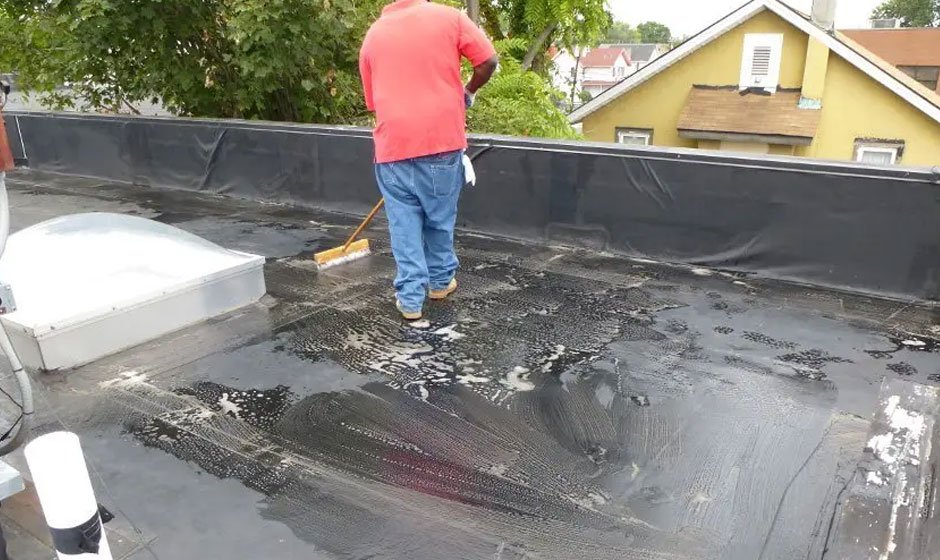Roofing and waterproofing are two essential elements of a building’s construction and maintenance. While they both serve to defend structures from the elements, they have distinct purposes and methodologies. We will delve into the differences between roofing and waterproofing, their specific functions, the materials utilized, and why each plays a paramount role in ensuring buildings’ longevity and structural integrity.
Roofing: Protecting from Above
Roofing is the construction or installation of the outermost layer of a building’s structure, designed primarily to shield the interior from diverse environmental elements such as rain, snow, wind, sunlight, and extreme temperatures. The preliminary purpose of roofing is to deliver shelter and preserve a livable interior environment. It also contributes to the aesthetic appeal of a structure.
Roofing materials vary widely and can include asphalt, metal panels, clay or concrete tiles, wood shingles, and more. The choice of roofing material pivots on factors such as climate, budget, architectural style, and local building codes. Roofing systems are typically sloped or pitched to allow water to flow away from the building. Proper installation and maintenance of roofing materials are crucial to preventing leaks, structural damage, and mold or mildew development within the building’s envelope.
Waterproofing: Keeping Water Out
On the other hand, waterproofing is the process of making a building or structure resistant to water infiltration. Unlike roofing, waterproofing focuses on stemming water from penetrating the building’s walls, foundations, and other vulnerable areas. Waterproofing measures are paramount for protecting against water damage, which can compromise a building’s structural integrity and usher to costly repairs.
Waterproofing materials and techniques are designed to create a barrier against moisture, including rain, groundwater, and surface water. Standard waterproofing strategies include the application of sealants, membranes, coatings, and installing drainage systems. Waterproofing is not limited to the exterior of a structure. It is often applied to below-grade areas such as basements and foundations and critical areas like bathrooms and kitchens. Properly executed waterproofing helps stem issues such as foundation cracks, mold growth, and deterioration of building materials due to moisture exposure.
Key Differences between Roofing and Waterproofing
● Purpose:
The fundamental difference between roofing and waterproofing lies in their purpose. Roofing primarily safeguards a building’s interior from weather elements like rain and snow, while waterproofing is dedicated to preventing moisture infiltration through walls, foundations, and below-grade areas.
● Location:
Roofing is predominantly installed on the topmost part of a structure, whereas waterproofing can be devoted to diverse parts of the building, including walls, foundations, basements, and paramount areas where water intrusion is likely.
● Materials:
Roofing materials are chosen based on their ability to withstand weather conditions and provide insulation. Common roofing materials include shingles, tiles, and metal panels. Waterproofing materials, in correspondence, concentrate on assembling a moisture barrier and often include membranes, coatings, sealants, and drainage systems.
● Slope vs. Barrier:
Roofing systems are often sloped or pitched to direct water away from the building. On the other hand, waterproofing creates a barrier to prevent water penetration.
● Function:
Roofing is primarily functional but can also contribute to the aesthetic appeal of a building. Waterproofing is mainly a practical aspect of construction, emphasizing moisture protection over aesthetics.
Why Roofing and Waterproofing are Both Essential
Both roofing and waterproofing are vital components of a building’s envelope, working together to ensure its long-term durability and occupant comfort. Neglecting one at the expense of the other can lead to serious structural and safety issues. Roofing protects the building from top-down moisture, such as rain and snow, preventing water from entering the structure through the roof. Proper roofing materials and installation techniques are essential to stem leaks, which can result in interior damage, mold growth, and compromised insulation.
Conversely, waterproofing guards against bottom-up moisture infiltration, particularly in areas where the building meets the ground or where water tables are high. Basements can become damp or flooded without effective waterproofing, leading to foundation issues, structural damage, and health concerns. Roofing and waterproofing serve distinct but equally critical roles in preserving a building’s integrity and ensuring the comfort and safety of its occupants.
Roofing and waterproofing are integral components of a building’s construction and maintenance, each serving distinct yet equally critical roles. Roofing protects the building from top-down moisture, such as rain and snow, while waterproofing prevents moisture infiltration through walls, foundations, and below-grade areas. Both systems require careful consideration, proper materials, and regular maintenance from professionals such as ContractorsIn Roofing & Waterproofing to ensure the longevity and structural integrity of a building. Understanding the differences between roofing and waterproofing is essential for architects, builders, and property owners to make informed decisions and protect their investments in construction and real estate. By comprehensively addressing roofing and waterproofing needs, you can create a safe, comfortable, and durable living or working environment.

